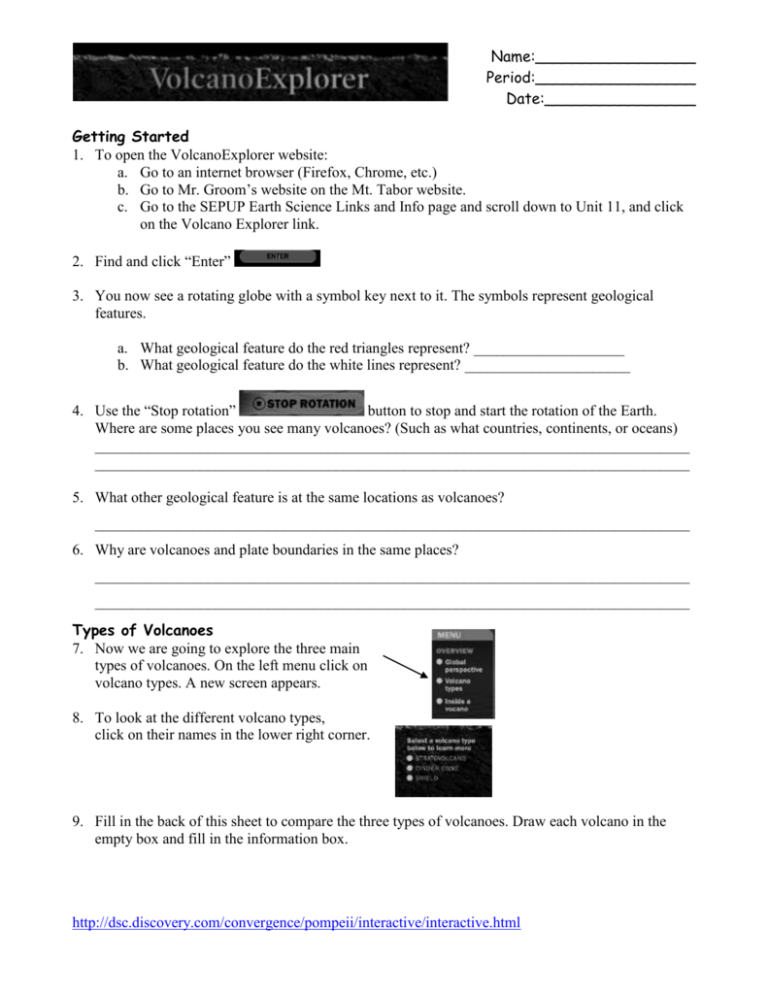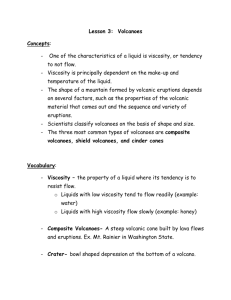Volcano Explorer Worksheet: Types, Eruptions & Viscosity
advertisement

Name:_________________ Period:_________________ Date:________________ Getting Started 1. To open the VolcanoExplorer website: a. Go to an internet browser (Firefox, Chrome, etc.) b. Go to Mr. Groom’s website on the Mt. Tabor website. c. Go to the SEPUP Earth Science Links and Info page and scroll down to Unit 11, and click on the Volcano Explorer link. 2. Find and click “Enter” 3. You now see a rotating globe with a symbol key next to it. The symbols represent geological features. a. What geological feature do the red triangles represent? ____________________ b. What geological feature do the white lines represent? ______________________ 4. Use the “Stop rotation” button to stop and start the rotation of the Earth. Where are some places you see many volcanoes? (Such as what countries, continents, or oceans) _______________________________________________________________________________ _______________________________________________________________________________ 5. What other geological feature is at the same locations as volcanoes? _______________________________________________________________________________ 6. Why are volcanoes and plate boundaries in the same places? _______________________________________________________________________________ _______________________________________________________________________________ Types of Volcanoes 7. Now we are going to explore the three main types of volcanoes. On the left menu click on volcano types. A new screen appears. 8. To look at the different volcano types, click on their names in the lower right corner. 9. Fill in the back of this sheet to compare the three types of volcanoes. Draw each volcano in the empty box and fill in the information box. http://dsc.discovery.com/convergence/pompeii/interactive/interactive.html Type of Volcano: __Stratovolcano____ Short or tall _____________ Made of/Built of: _______________ _____________________________ Description of shape: _____________ _____________________________ Example: ______________________ Type of Volcano: Shield__ Large or small: ________________ Made of/Built of: _______________ _____________________________ Description of shape: _____________ _____________________________ Example: ______________________ Type of Volcano: Cinder Cone_ Short or tall: __________________ Made of/Built of: _______________ _____________________________ Description of shape:_____________ _____________________________ Example: ______________________ http://dsc.discovery.com/convergence/pompeii/interactive/interactive.html What’s on the inside of a volcano? 10. Click on “Inside a Volcano” (on the left menu) 11. Use the diagram on the screen to fill in the diagram of the inside of a volcano below. How does viscosity affect eruptions? 12. Now click on on the left side menu. 13. A volcano is affected by the viscosity and gas of its magma. Click on the “Viscosity Info” button at the bottom. A small box will pop-up near the volcano. Read the information to answer: a. What is viscosity? ________________________________________________________ b. What makes lava viscous? ________________________________________________ http://dsc.discovery.com/convergence/pompeii/interactive/interactive.html 14. Change the viscosity to see how it affects the magma. To do this, move the viscosity arrow up and down. Look at the box of moving magma on the left. The magma in this window changes when you change the viscosity and gas. a. When the viscosity is high the magma moves (circle one) slower or faster. b. When the viscosity is low the magma moves (circle one) faster. slower or 15. You can also change the gas content. Compare the low gas to the high gas setting. How is the magma different when it is on high? (Hint: Look at the bubbles) __________________________________ 16. Now you are going to try and build a few types of volcanoes. Get out your Table of Volcanic Eruptions you made in class yesterday. The lava flow rate is caused by viscosity. a. If the lava flow rate is slow, then viscosity is ____________________. b. If the lava flow rate is fast, then viscosity is______________________. Building Volcanoes – Use your Table of Volcanic Eruptions to figure out how to make each of the following volcanoes 17. Shield Volcano – Gas setting: Low or high a. Make a prediction: What viscosity setting will make a shield volcano?___________________ b. Try it out. What type of volcano did you get?_______________________ c. If you didn’t get a shield volcano, keep trying. What viscosity setting makes a shield volcano? ___________________________ 18. Stratovolcano – Gas setting: High a. Make a prediction: What viscosity setting will make a stratovolcano?___________________ b. Try it out. What type of volcano did you get?_______________________ c. If you didn’t get a stratovolcano, keep trying. What viscosity setting makes a stratovolcano? ___________________________ 19. Dome – Gas setting: low a. Make a prediction: What viscosity setting will make a dome?___________________ b. Try it out. What type of volcano did you get?_______________________ c. If you didn’t get a dome, keep trying. What viscosity setting makes a dome? ___________________________ 20. Look at your table. How does viscosity affect the type of volcano and eruption? _________________________________________________________________________________ http://dsc.discovery.com/convergence/pompeii/interactive/interactive.html




